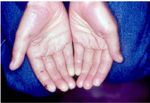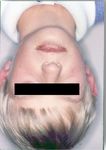Papillon-Lefèvre Syndrome - A Rare Case Report - JSciMed Central
←
→
Page content transcription
If your browser does not render page correctly, please read the page content below
Central JSM Dentistry
Case Report *Corresponding author
Marina Gonçalves de Andrade, School of Dentistry,
Papillon-Lefèvre Syndrome - A Federal University of Bahia, St. Rio São Francisco, n 279,
Neighbourhood Recanto das Árvores, ZIP code: 44900-
000, Irecê-Ba, Brazil, Tel: 55 (71) 99355-4036; Email:
Rare Case Report Submitted: 28 July 2018
Accepted: 24 August 2018
Marina Gonçalves de Andrade*, Ana Carolina Fraga Fernandes,
Published: 27 August 2018
Bruna Pedral Sampaio de Souza Dantas, Larissa Oliveira Ramos Silva,
ISSN: 2333-7133
Mariana Machado Mendes de Carvalho, Paloma Heine Quintas, and
Copyright
Roberto Almeida de Azevedo © 2018 de Andrade et al.
School of Dentistry, Federal University of Bahia, Brazil
OPEN ACCESS
Abstract Keywords
Papillon-Lèfevre is a rare syndrome, autosomal recessive, which shows dermatological and • Papillon-Lefèvre syndrome
periodontal tissue manifestations. The main oral manifestation is aggressive periodontitis that • Palmoplantar Keratosis
happen even in primary or permanent dentition. Radiography shows the loss of bone insertion • Periodontal Disease
identified as floating teeth. Skin lesions are presented as palmoplantar keratosis, plaques and
white, light yellow, brown or red spots that develop crusts, crevices or deep fissures. The aim
of this study is to present a rare case report of a child-juvenile patient with Papillon-Lefevre
syndrome and its ways of recognition and treatment.
INTRODUCTION corticosteroids or antibiotics [3]. In oral manifestations, the
treatment involves antibiotic therapy and intense periodontal
Papillon-Lèfevre syndrome was first described in 1924 by therapy, but with different applicabilities [1,2,5,6].
Papillon and Lefevre [1,2] as variant of “Mal de Meleda” [2]. It is
a rare syndrome affecting 1-4 people per 1 million inhabitants, The aim of this study is to present a rare case report of a child-
autosomal recessive [1-6], belonging to a group of pathologies juvenile patient with Papillon-Lefevre syndrome and its ways of
associated with palmoplantar keratosis, and with dermatological recognition and treatment
and periodontal characteristics [2,6]. Its etiology is unknown
and there is no predilection for gender [1,2,5,6]. Around 1%
CASE PRESENTATION
of cases are based on genetic issues besides its association to A 12-year-old male patient (Figure 1) went, student, with
immunological causes. his mother, to the Oral and Maxillofacial Surgery Service of
Universidade Federal da Bahia (UFBA), in Salvador, Bahia, Brazil
The main feature of this syndrome is the aggressive
referring severe toothache, halitosis, and recurrent gingival
periodontitis associated to the palmoplantar keratosis [1,2,4-
bleeding. He mentioned softening and falling teeth about three
6], but these characteristics may be separated initially.
years ago.
Transgressive and diffuse palmoplantar keratosis is the main
dermatological manifestation [1,6], showing plaques and white, During clinical examination was observed a hyperemic
light yellow, brown, or red spots which develops crusts, crevices gingiva (Figure 2), an easily bleeding at touch, and a considerable
or deep fissures. Other keratinocyte lesions may appear in other mobility in almost all teeth. Hematology tests and periapical
sites such as skin, knees and elbows and the lesion severity radiography were requested.
predominates during winter [1,2,6].
The hematology tests had no alterations and radiographies
Aggressive periodontitis appears as soon as teeth eruption showed (Figure 3-5) generalized bone loss in all sextants. A
leading to a quick loss of bone insertion and support [1,2,4-6]. more detailed anamnesis was done and findings of palmoplantar
Defects in neutrophil function and multiple immune-mediated keratosis (Figure 6,7) and complaints ignored by the genitor
mechanisms apparently trigger this phenomenon [2]. because she judged less important in a dental consultation and
Radiographically, it appears as floating teeth in soft tissue therefore it was not previously informed were decisive for the
because of the rapid alveolar bone resorption [5]. Papillon- diagnosis of Papillon-Lèfevre syndrome. The patient reported that
Lèfevre syndrome makes differential diagnosis with Haim-Munk the keratoses lesions were asymptomatic, but they were frequent
syndrome in virtue of the clinical findings [1,3,5,6]. foci of infections. Faced with this finding, the marriage’s history
of the parents was investigated, who were not consanguineous.
The administration of retinoid shows the best treatment
result for skin lesions. However, due to many adverse reactions The patient was referred to Periodontics Service at Dentistry
[1], in milder cases are used topical lubricants, keratolytic agents, College of Federal University of Bahia and was diagnosed with
Cite this article: de Andrade MG, Fraga Fernandes AC, de Souza Dantas BPS, Ramos Silva LO, de Carvalho MMM, et al. (2018) Papillon-Lefèvre Syndrome
- A Rare Case Report. JSM Dent 6(2): 1109.de Andrade et al. (2018)
Email:
Central
general aggressive periodontitis. Extractions of remains of
primary teeth, scaling, root planning, plaque control, and oral
hygiene instructions were planned. Antibiotic therapy was
started with tetracycline 20 mg/kg/day orally for ten days. The
dose may be repeated as judged by the need assessed by the
professional.
The patient and his mother were enlightened about the
disease and he was also referred to the doctor to evaluate and
treat cutaneous lesions.
DISCUSSION
Papillon-Lèfevre syndrome is autosomal recessive in which
both parents are carries of the defective gene and the risk of
affected children is approximately 25%. It is also a keratinization
Figure 1 Patient in frontal photo.
disorder characterized by redness, thickening of the plants
and palms of the hands and severe and destructive periodontal
disease [7,8].
Besides its unknown etiology, at a genetic level, the gene 11q
Figure 2 Gingival hyperemia.
Figure 5 Generalized bone loss at sextants 3,6.
Figure 6 Palm keratosis.
Figure 3 Generalized bone loss at sextants 1,3.
Figure 4 Generalized bone loss at sextants 2,5. Figure 7 Plantar keratosis.
JSM Dent 6(2): 1109 (2018)
2/3de Andrade et al. (2018)
Email:
Central
and mutation at Cr 12 and 17, which produce cytokeratin, have erythromycin, but in some cases systemic antibiotics such as
been associated to [1,2]. Studies such as that of Toomes et al. [7], amoxicillin (20-50 mg/kg/day) plus metronidazole (15-35
point out that one of the causes involved in the development of mg/kg/day) in divided doses of 8 hours are used as adjunctive
the syndrome is also the gene gene mutation of cathepsin C found treatment to the conventional treatment. In the present
in commonly affected epithelial regions. report, tetracycline was used, which shows good results in the
periodontal treatment, already based on the literature [8].
Other factors are associated: anatomic, viral, and microbial
agents and host response. In the sub gingival plaques of It is concluded that the Papillon-Lefèvre syndrome can be
periodontal pockets, the most frequent microbial agent, which easily diagnosed by dentists, due to the association of clinical
covers all age groups, is Actinomyces actinomycestemcomitans [1], and radiographic findings related to generalised aggressive
considered as one of the suspected periodontal pathogens [7-9]. periodontitis, as well because of the characteristics of
palmoplantar keratosis. It is necessary a cautious look, giving
Papillon-Lèfevre syndrome is restricted, for the most part, to
importance to lesions that are far from the oral cavity, and that
study cases because of it is a rare pathology [6,10]. Few studies
can be crucial for the closing of the early diagnosis, leading to an
demonstrate alterations in saliva and gland function, severe
optimization of the treatment.
periodontal bone destruction caused by neutrophil dysfunction
in addition to deregulatory factors of the cells of immune system CONFLICT OF INTEREST
[1,2,10].
The author(s) declare(s) that there is no conflict of interest
The differential diagnosis includes acrodynia, hypophospha- regarding the publication of this paper.
tasia and cyclic neutropenia. Although these illness are associat-
ed to palmoplantar hyperkeratosis, the periodontitis is not seen REFERENCES
in them [7,10]. 1. Papillon MM, Lefèvre P. Two cases of family symmetrical keratoderma
palmar and plantar (disease of Meleda) in the brother and the sister.
In order to investigate the syndrome, laboratory tests Coexistence in both cases of serious dental deteriorations. Bull Soc Fr
such as urine analysis, alkaline phosphatase, hormone tests, Dermatol Syphiligr. 1924; 31: 82–87.
blood count, neutrophil function test, may be asked. However,
2. Korkmaz B, Caughey GH, Chapple I, Gauthier F, Hirschfeld J, Jenne DE,
all of them are within the normal range for Papillon-Lefèvre
et al. Therapeutic targeting of cathepsin C: from pathophysiology to
Syndrome, being important to rule out other pathologies [7-10]. treatment. Pharmacol Ther. 2018; S0163-7258: 30091-30093.
As observed in the case report, the patient in question had no
alterations in laboratory tests, and in view of the clinical evidence 3. Iqtadar S, Mumtaz SU, Abaidullah S. Papillon-Lèfevre syndrome with
palmoplantar keratoderma and periodontitis, a rare cause of pyrexia
of plantar palmar keratosis and the early inflammation of the
of unknown origin: a case report. J Med Case Rep. 2015; 9: 288.
mixed dentition, there was no doubt about the Papillon-Lefèvre
diagnosis. Therefore, more specific exams such as biopsy of 4. Alsarheed M, Al-Sehaibany F. Combined orthodontic and periodontic
gingival or keratotic lesions, chromosome analysis, are necessary. treatment in a child with PapillonLefèvre syndrome. Saudi Med J.
2015; 36: 987-992.
Skin lesions usually start in the first four years of life. The
5. Hamon Y, Legowska M, Fergelot P, Dallet-Choisy S, Newell L,
treatment in milder cases is the use of topical lubricants and Vanderlynden L, et al. Analysis of urinary cathepsin C for diagnosing
keratolytic agents [1], corticosteroids or antibiotics [3]. The Papillon-Lefèvre syndrome. FEBS J. 2016; 283: 498-509.
administration of retinoid has showed the best treatment results
6. Neville B, Damm DD, Allen CM, Bouquot J. Oral and maxillofacial
for skin lesions in both epidermis and oral cavity, but it presents pathology. 3rd edn. Philadelphia: WB Saunders. 2004; 778-781.
many adverse effects [1]. Normally the recommended starting
dose for acitretin is 0.5mg/kg/day5 and 1.5mg/kg/day for 7. Toomes C, James J, Wood AJ, Wu CL, McCormick D, Lench N, et al. Loss-
of-function mutations in the cathepsin C gene result in periodontal
isotretinoin [7,10].
disease and palmoplantar keratosis. Nat Genet. 1999; 23: 421-424.
The patient was referred to the dermatologist so that specific 8. Roberts H, White P, Dias I, Mc Kaig S, Veeramachaneni R, Thakker
and individualized treatment of the skin lesions could be done. He N, et al. Characterization of neutrophil function in Papillon-Lefèvre
did not return to the team that made the diagnosis and therefore syndrome. J Leukoc Biol. 2016; 100: 433-444.
it was not possible to follow the progress of the treatment.
9. Coeli FR, Macedo DM, Batista MD, Cestari SCP, Rotta O. Você conhece
In oral manifestations, the treatment is, at most, palliative essa síndrome? Síndrome de Papillon-Lefèvre. An Bras Dermatol.
and involves antibiotic use associated to extractions of primary 2008; 83: 375-377.
dentition, intense periodontal therapy, and oral hygiene, which 10. Pham CT, Ivanovich JL, Raptis SZ, Zehnbauer B, Ley TJ. Papillon-
have showed effective results to maintenance and preparation of Lefévre syndrome: correlating the molecular, cellular, and clinical
the oral cavity for the permanent dentition [1,2,5,6]. consequences of cathepsin C/ dipeptidyl pepdidase in humans. J
Immunol. 2004; 173: 7277- 7281.
The commonly used antibiotics are tetracycline and
Cite this article
de Andrade MG, Fraga Fernandes AC, de Souza Dantas BPS, Ramos Silva LO, de Carvalho MMM, et al. (2018) Papillon-Lefèvre Syndrome - A Rare Case Report.
JSM Dent 6(2): 1109.
JSM Dent 6(2): 1109 (2018)
3/3You can also read






















































